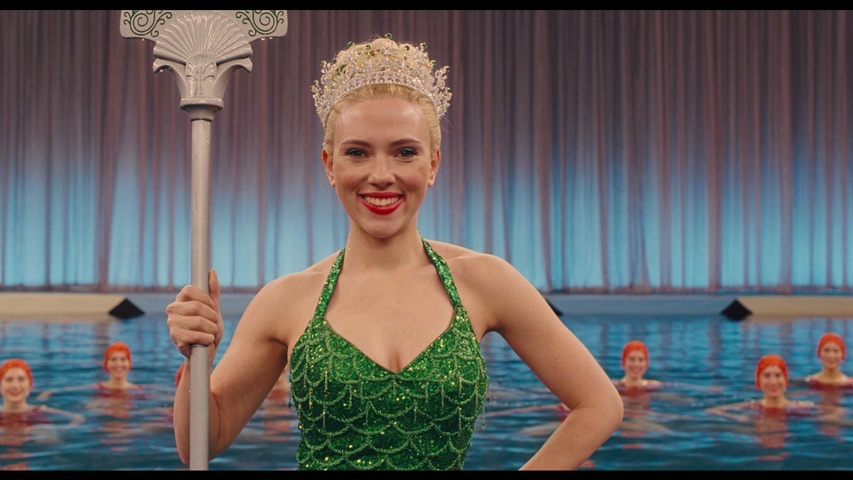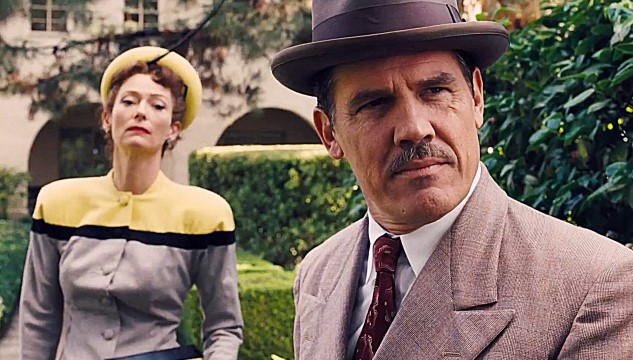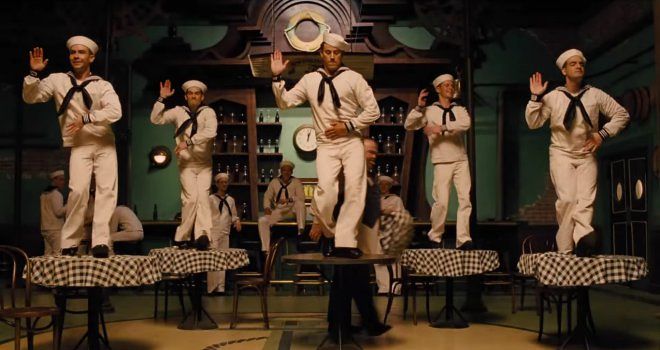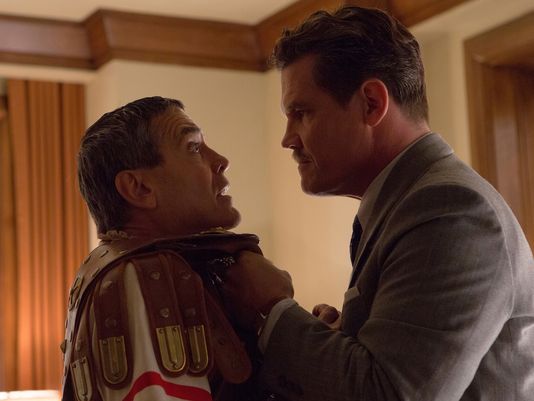Hail, Caesar! is two movies that are really one movie: the Coen Brothers film Hail, Caesar! that you the viewer are watching, and Capitol Pictures’ troubled prestige picture Hail, Caesar!. The blurred line between the film and the golden age of Hollywood film-within-a-film is immediate and obvious, placed on a marble column for the viewer when put-upon head of production Eddie Mannix (Josh Brolin) watches dailies from the film. The opening title card he sees—HAIL, CAESAR! A STORY OF THE CHRIST—functions as the opening title for the movie we’re watching. Michael Gambon narrates both that movie and our movie with no clear delineation between the two. Even Mannix, as a fictionalized, greatly idealized version of a real-life studio head, exists somewhere between fact and fiction. Capitol has their financial year riding on the success of its Hail, Caesar! and in turn the Coen Brothers have swung for the fences with a messy, titanic-in-scope release that poses more questions than it answers (but the questions it poses are pretty fucking interesting ones).
The Coens’ symbolism has never been more overt than it is here. Tilda Swinton’s Hedda Hopper-inspired twin reporters Thessaly and Thora are not only identical, but appear in succession in any given scene. Not only that, but both sisters’ invocation of a specific movie title cues the sound of an eagle cry as if it’s the sound of a clock striking a new hour. Significant elements of the Capitol films we see later reappear in the larger film itself. Roger Deakins’ shot of the moon in aw-shucks cowboy actor Hobie Doyle’s (Aldren Ehrenreich) latest Western shows up minutes later over the Pacific Ocean; Scarlett Johansson’s DeeAnna Moran is swallowed by a prop whale during a water ballet number and seen thematically toward the end of the film when a defecting Hollywood actor enters a Soviet submarine. All of this informs Hail, Caesar!‘s particularly unusual rhythm, which is also embodied in the minute hand movements of our ensemble lead, Eddie Mannix.
Eddie Mannix is a great character very much in the vein of Coen Brothers hall of famers like H.I. McDunnough, Marge Gunderson, and Everett McGill. Our introduction to Mannix, violently busting up a risque photoshoot in violation of a young starlet’s studio obligations before seeking late night confession, shows us that he is meticulous in all aspects of his life, even sinning and atonement. Mannix virtually never stops moving; his role as a “fixer” for Capitol Pictures requiring him to put out perpetual fires both on and off the studio backlot. The Coens are among the few directors to utilize Josh Brolin as a leading man, and Mannix’s presence as the ostensible main character is reminiscent of a sort of alternate universe Pulp Fiction that only centered around Harvey Keitel’s The Wolf.
The Hail, Caesar! overseen by Mannix is a story about Jesus and, in turn, Mannix himself is something of an unorthodox Christ figure whose job it is to absolve the sins of Hollywood stars and directors. Mannix never sleeps, moving from meeting to meeting like a benign shark in a suit, and returning home only briefly to eat a reheated pot roast. When informed of his children’s respective accomplishments at school and during after school sports, Mannix warmly acknowledges them as problems that have been solved without his help. Mannix is haunted by his distance from his family and tempted by the lingering offer of a management position laid at his feet by an eager headhunter for the Lockheed Corporation, who dismisses filmmaking as frivolity before giddily showing off a Polaroid of an H-bomb test to Mannix. The blossoming military-industrial complex of the early ’50s is pitted as the antithesis of art, even the capitalism-driven shlock art Mannix is charged with overseeing.
The assembly line musicals and cowboy features made by Capitol Pictures betray the Coens’ underlying philosophy towards not just filmmaking but art in general. When we watch the filming of these scenes, it’s notable that we see virtually entire scenes. When we watch Channing Tatum’s Burt Gurney tap dance, it’s not as a brief visual gag. The chorus lines and synchronized swimming are spectacle, but Hail, Caesar! argues that there is value and even nobility in the craft that goes into spectacle. Taking it even further, the film frames Mannix’s devotion to professionalism in a creative field as a sign of good character, and the “easy job” offered by Lockheed as a path to weakness. The Coens make no apologies for the affairs and scandals Mannix has to cover up, only that they are sins to be swallowed by him so that art can be made.
The Coens’ choice to fill their film with A-list stars in largely minor roles as fictional A-list stars, intentionally or unintentionally, gives Hail, Caesar! a palpable sense of unease. Characters like Hobie Doyle or George Clooney’s buffoonish Baird Whitlock never find true self-actualization, resigned to minor failures and successes short of the kind of tidy bow their on-screen roles are afforded. The trade-off here is that, Mannix notwithstanding, there isn’t a terrific amount of payoff.
Just as a desperate Eddie Mannix is unable to get an even remotely coherent summation of Christ from an assembled cross-faith panel of religious elders, Hail, Caesar!‘s open questions about art, faith and commerce are almost too big to fully take in. The Coens’ conclusion, such as it is, is that in the face of the infinite, there is only the work we do that matters.
Hail, Caesar! is now playing in theaters everywhere.






